BY LETTER
Shellworlds
Technology > Technology Type or Material > Drytech/Hylotech
Technology > Application > Infrastructure
Technology > Application > Megascale Engineering
Technology > Technology Levels > Middle Tech / Midtech
Technology > Technology Levels > Ultratech
Technology > Application > Infrastructure
Technology > Application > Megascale Engineering
Technology > Technology Levels > Middle Tech / Midtech
Technology > Technology Levels > Ultratech
Worlds with several concentric habitable layers | |
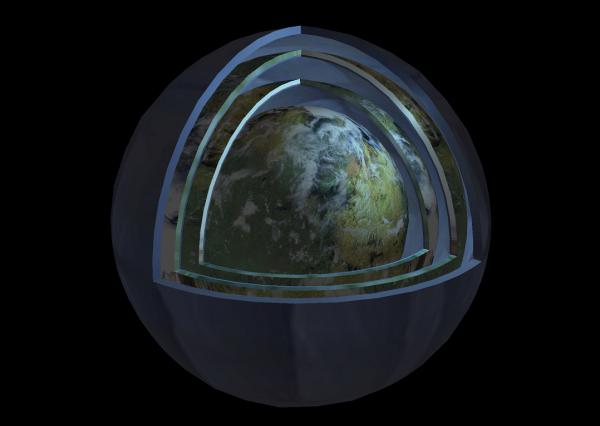 Image from Steve Bowers | |
| This shellworld (seen in cross-section) consists of several Earth-like levels | |
The concept of shellworlds was first proposed in the early Information age, but did not become possible until the development of mature nanotech.
Medium-tech (Type 1) shellworlds consist of a series of habitable shells constructed using the crust of a tectonically quiescent world, extending above and below the surface.
High-tech (Type 2 shellworlds) are pneumatically-supported structures suspended inside the atmospheres of large planets.
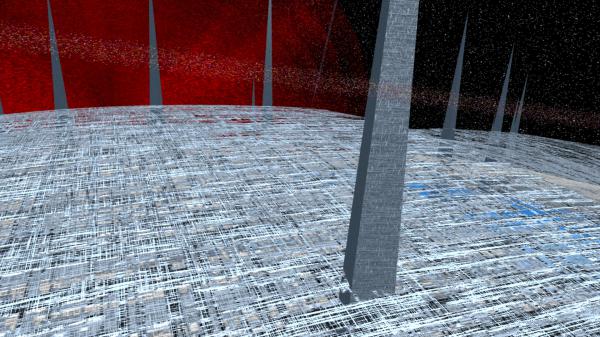 Image from Darren Ryding | |
| A Type 3 shellworld (an artificial planet with several habitable layers) under construction on the edge of a Dyson cloud. For a scale reference, there are 16 thousand ships in the foreground, each the size of a sea-going freighter. | |
A more advanced design (Type 3 shellworlds) consist of several dynamically supported shells, essentially a series of concentric artificial planets.
Medium-tech (Type 1) Shellworlds
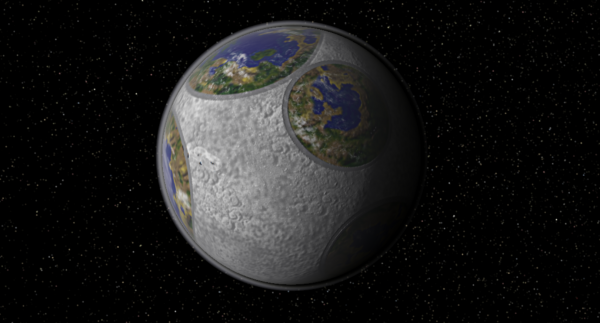 Image from Steve Bowers | |
| Galrecon Type 1 shellworld | |
Given an inactive world, such as a Selenian or Hermian terrestial planet, the construction of a shellworld is one way of creating a large habitable area. A layer of earth below the planet's surface is excavated with self-replicating technology to produce a series of habitable caverns beneath the planet's surface. Eventually the caverns are connected together into a nearly continuous shell. This shell is filled with with air and water, often imported from elsewhere in the system; artificial light sources on the ceiling provide sunlight. The power for these light sources may come from fusion, or solar power collectors on the surface or in orbit.
However, in a type 1 Shellworld, the excavated stone is utilised in an ingenious manner. This material is formed into new shells that rise above the planet's original surface, providing extra habitable spaces which can be pressurised. Using assembler technology the excavated crust can be assembled into structural materials that support the weight of the levels above them through huge pillars, (usually consisting of diamondoid or corundumoid), and when excavation is complete the planet has many concentric habitable layers and has many times more surface area than before.
Naturally, finding a largish but non-tectonically active body (lacking conventional or large large amounts of radioactivity in the deep crust, mantle and core and small enough that the friction heat wouldn't be enough to melt rock and form tectonic plates) is not easy. Suitable candidates that have been used are a few unusually stable very old Mars-like planets, some rocky outer worlds in old white dwarf systems, and even "lost" or "rogue" planets. The minimal seismic activity that occurs even on these bodies is manageable using large scale allocation of basic nanotechnology.
Medium-tech shellworlds were originally powered by intercepted sunlight or fusion power plants, or a mixture of the two. Many shellworlds now use conversion technology as a power source instead.
Waste heat from the various levels is often a problem, often requiring elaborate cooling systems to maintain a comfortable climate on each level.
Galrecon is an example of a type 1 shellworld, unfortunately damaged in the Version War.
High-Tech (Type 2) Shellworlds (supported by gas pressure)
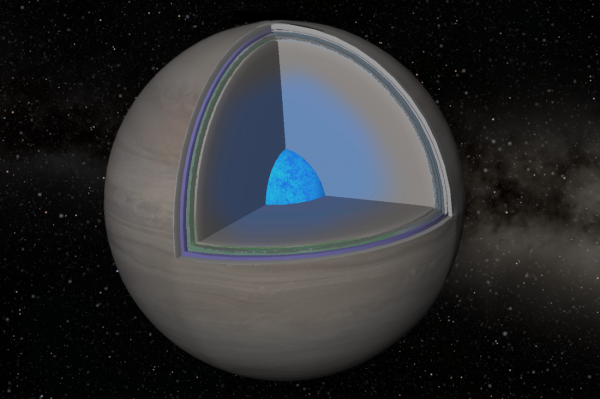 Image from Steve Bowers | |
| Purcell, a Neptune-type world, has two continuous artificial habitable surfaces suspended by gas pressure inside its atmosphere. The lower layer has an atmospheric density several times higher than a normal Earth-like environment, and consists mostly of inert helium and a breathable partial pressure of oxygen. | |
Another type of shellworld can be created using shells that are supported by the pressure of the air beneath them, rather than by solid pillars. Each shell is constructed incrementally by creating bubblehabs or fullairs (which can act as habitats or serve other uses during shell construction) and linking them into ever-growing rafts, eventually forming a continuous shell.
Since the components of a Type 2 shellworld are formed in an atmosphere, they are subjected to the effects of wind. During construction of shells, all or most of the bubblehabs/fullairs will need to be able to function as weather machines to control the wind and prevent it from disrupting the shells. Even then, some planets are simply too windy or turbulent for this type of shellworld.
In a Type 2 shellworld, the air pressure increases rapidly for lower (i.e. deeper) shells, due to the weight of the upper shells being transmitted to lower shells. Consequently, shellworlds of this type support a range of sophonts, each adapted to a different pressure level. Lower levels often utilise helium as the main component, to avoid nitrogen narcosis (which affects many, but not all biont clades).
An example of a partly completed type 2 shellworld can be found at Blanchard. The neptune-like world Purcell in the MPA has two complete shells supported by gas pressure, and is currently constructing a third.
Ultra-tech (Type 3) Shellworlds
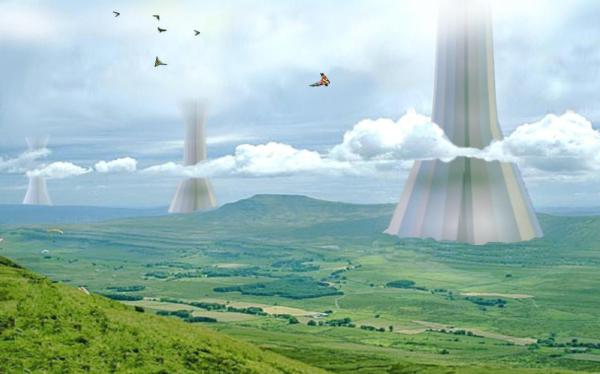 Image from Steve Bowers | |
| The diamondoid towers separating the layers of Yoredale shellworld were originally coloured luminous blue, the same as the sky/ceiling. When gliding became popular on this world there were several unfortunate accidents, so the towers are now clearly visible by day and night | |
By constructing a network of dynamic orbital rings above a planet or even an artificial black hole, an artificial planetary surface of almost any size can be constructed. This technology allows an arbitrary number of concentric layers to be suspended one above another, with the only practical limits being the energy requirements for each shell and the removal of waste heat. The different layers can each have very different environmental conditions, but the connecting lift-shafts must be evacuated to prevent contamination between levels.
Ultra-tech shellworlds may be powered entirely by the central black hole, or by conversion technology. Light from nearby stars may also be used where available. Drifting Stevensonian planets in interstellar space make excellent candidates for conversion. More than a few clades, both mainstream and hiders, have constructed shellworlds in this manner.
Related Articles
Appears in Topics
Development Notes
Text by Michael Beck, amended by Tardigrada 2021
With additional material by Steve Bowers
Initially published on 31 December 2001.
With additional material by Steve Bowers
Initially published on 31 December 2001.
Additional Information
Shell Worlds -2009 paper by Roy, Kennedy, Fields
http://www.ultimax.com/whitepapers/ShellWorldsJBISfinal.pdf
Isaac Arthur's YouTube video about Shellworlds here
Shellworlds
http://www.ultimax.com/whitepapers/ShellWorldsJBISfinal.pdf
Isaac Arthur's YouTube video about Shellworlds here
Shellworlds






